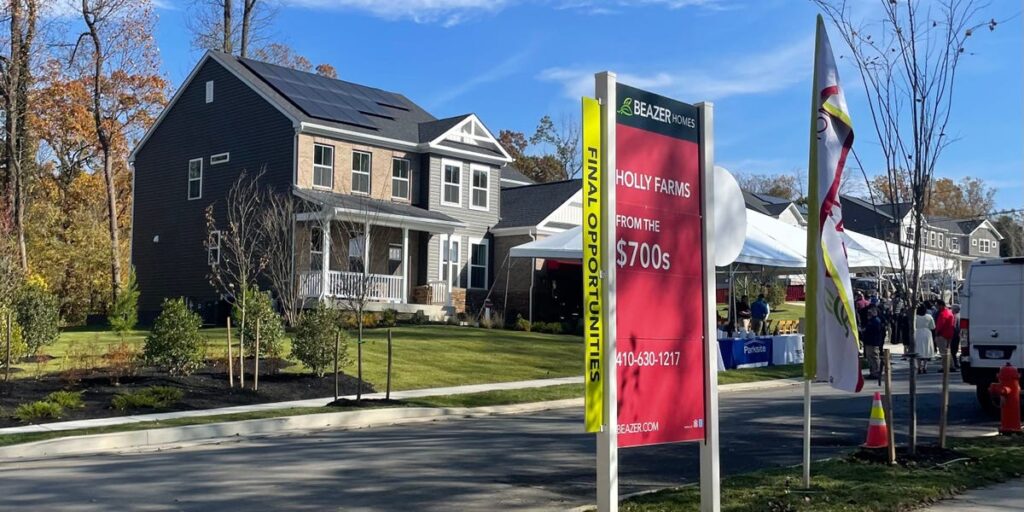- Beazer Homes is building “zero energy,” climate-friendly homes even though they’re more expensive.
- CEO Allan Merrill said the upfront investment will pay off long-term.
- Challenges include higher costs, market education, and appraisal practices for green homes.
A new community of 19 single-family homes north of Baltimore is at the forefront of the green-building movement.
Solar panels are on the roofs. Garages come with electrical-vehicle charging. Energy-efficient appliances, including electric heat pumps and induction stoves, are installed. Airtight insulation prevents leaks that waste energy. Fresh-air systems keep indoor air clean. The homes use so little energy that solar could offset most or all energy utility costs.
The project was developed by Beazer Homes, one of the largest US homebuilders. Several years ago, the company set a goal that by 2025, all its new homes would meet the US Department of Energy’s “Zero Energy Ready” certification. Its CEO, Allan Merrill, said Beazer was close to meeting the goal.
The effort has come at a cost; Merrill said climate-friendly features can add $10,000 to $30,000 to construction and that the market for these homes is still emerging. It’s also a precarious time, with so many Americans struggling to afford a home and the reelection of Donald Trump threatening to reverse many environmental regulations. But there are tailwinds, including state laws that require industries like utilities and real estate to decarbonize and a record amount of renewable-energy projects across the US.
Merrill thinks the up-front investment will be worth it in the long term, even if shareholders haven’t rewarded Beazer yet. Prioritizing sustainability helps the company attract the best talent, he said, and homeowners are increasingly concerned about rising utility costs. Now Beazer has to educate customers and the broader real-estate market about the value of green homes.
“Leadership requires investment,” Merrill said. “We made a conscious decision to make less money on all of these homes. Now it’s about talking to more customers, becoming more effective at communicating the value, and getting paid for it.”
Merrill added that Beazer is in the middle of that journey. The 19 single-family homes in Parkville, Maryland, cost at least $700,000, which is more than double the area’s median sales price in September of $300,000.
Merrill said the value of Zero Energy Ready homes comes from lower utility bills, healthier air quality, a quieter living space, and a reduced environmental impact. Beazer estimated that owners of the new homes in Parkville would save about $453 a month in energy-utility costs compared with owners of older homes in town, and $311 a month compared with owners of a typical new build. Better indoor air quality is a selling point for buyers with asthma or other respiratory problems. Renewable energy and electric appliances don’t emit fossil fuels.
“The tricky thing is when people walk in, they’re not wearing a button that tells you which of those issues are relevant to them,” Merrill said. “That’s the discovery process. It’s finding a way to connect what we’ve done to each buyer.”
He said another challenge is that home appraisals generally don’t account for energy efficiency or renewable-energy technologies.
Woody Fincham, a residential appraiser in Charlottesville, Virginia, who also teaches courses on sustainable homes for the Appraisal Institute, says few appraisers have the expertise. But he argued that the problem is broader. Real-estate agents need to market green features so that prospective buyers understand their value, which then has to be communicated to mortgage lenders who can seek out qualified appraisers.
Still, there’s no guarantee that a green home can fetch a higher price, because the market largely depends on what’s sold nearby.
“If you’re in a community where people put a lot of value on efficiency — and there are some parts of the country where they do — the appraisal will be able to show that the market is willing to pay more,” Andrew Pizor, a senior attorney at the National Consumer Law Center, said. “But if you’re in a community where people don’t care about that kind of thing, the appraiser is going to compare prices and likely find that no one’s willing to pay extra for it.”
Two Democrats in Congress have proposed legislation that would require appraisals to consider a home’s energy use compared with that of nearby properties, as well as whether the home has energy-efficient appliances, solar panels, and EV charging. The bill would also require additional training for appraisers.
But it hasn’t passed, and Merrill said Beazer isn’t waiting around.
Read the full article here















